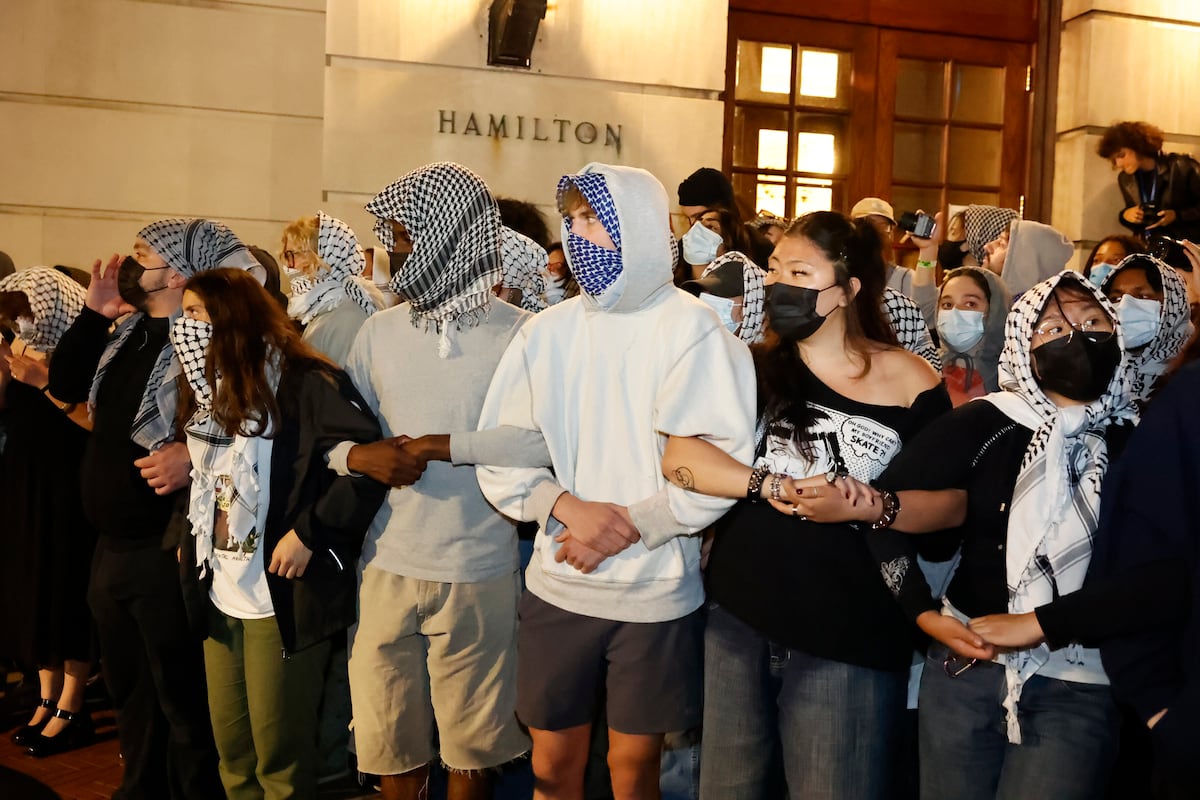Columbia University remains in a tense calm this Tuesday after the occupation of one of the campus buildings by a group of students camped on the campus for almost two weeks in solidarity with Gaza. The threat of academic suspension – with the risk of being expelled from their residences and even losing the semester – to the campers who did not voluntarily abandon the 80 remaining tents on Monday, led a group of protesters early on Tuesday , hooded and muffled to avoid being identified, to barricade themselves in the Hamilton Hall building, with a long tradition of lockdowns since the Vietnam War and the massive protests on campus in 1968. To the White House, which until this very Monday they had avoided To speak out on the mobilization, he said this Tuesday that the takeover of a building is “an absolutely wrong approach and not an example of peaceful protests.” Protests have escalated on other American campuses with dozens of arrests.
The authorities of Columbia, the epicenter of the student mobilization in solidarity with Gaza that has burned down US campuses, are trying by all means to avoid resorting to the police to evict the camp — which they consider violates university policy and disrupts its normal operation—to avoid a repetition of the repression that two weeks ago managed to evacuate the first camp, with a hundred arrests, but that further inflamed the protest and lit the flame of mobilization throughout the country. Following the occupation of the building, the rectorate has closed all entrances to the campus except one, the one closest to Hamilton Hall, and has limited entry to students living in one of the seven residence halls and essential personnel. He has also threatened those entrenched in the building with expulsion, because “they have chosen to escalate to an unsustainable situation,” said the spokesperson, Ben Chang. On other US campuses, the camps have been lifted, not without tensions, such as the intervention of riot forces at the University of Texas-Austin the day before with dozens of arrests. This morning those from Connecticut, Yale and the University of North Carolina were evacuated.
A video published on social networks by Columbia University Apartheid Divest (CUAD), the umbrella that brings together a hundred student groups and leads the protests, shows the irruption into the building of “an autonomous group” composed by several dozen students after breaking the glass of the door with a hammer, as well as the subsequent introduction of fences inside it. Other already viral images reflect furniture parapets with which they have blocked the doors to protect themselves from possible police intervention. In a message posted on the networks, CUAD points out that “this escalation is in line with the historic student movements of 1968 (Vietnam), 1985 (South African apartheid) and 1996, which Columbia repressed then and celebrates today.” In 1996, a hundred students locked themselves in the same building to ask the rectorate to create an ethnic studies group. “This action will force the university to confront the blood on its hands,” CUAD’s explanation continues. The organization points out the failure of “good faith” negotiations with the university authorities and their threat of “massive suspensions and expulsion, even considering calling the National Guard” against the protesters, a possibility in principle ruled out by the governing board, as well as resorting to the police.
The occupants, who have renamed the building Hind Hall in memory of Hind Rajab, the Palestinian girl who died two months ago surrounded by corpses while crying for help for hours, They have announced that they will remain locked up until the University withdraws all its investments from companies linked to Israel. The demand from Columbia students is more rigorous than that of other campuses, which ask that their alma mater Disconnect your investments only from companies in the military industry. The case of the Columbia protesters is a major ordeal, impossible to sign up for, since already in February, two months before the massive protest broke out, the university announced that it had no intention of divesting from companies linked to Israel. Columbia has a portfolio of 13,600 million dollars (about 12,731 million euros), managed by its own investment fund.
Join EL PAÍS to follow all the news and read without limits.
Subscribe
Columbia’s now almost total shielding has excluded students who live off campus, but who go to its dining halls daily. The neighboring Barnard College, where Jewish students are concentrated, has enabled an alternative food service. But all the entrances to Columbia, from the main entrance – where more media than students were gathered this Tuesday – to the rear ones that lead to a cafeteria or the gym, are closed and locked. Columbia authorities are weighing when and how to make a move, without provoking a new shock wave contrary to their interests, when the graduation ceremonies are just a few weeks away. Meanwhile, activists, NGOs such as Amnesty International and Human Rights Watch and institutional representatives such as the UN High Commissioner for Human Rights, Volker Türk, have regretted the forceful measures adopted by some universities to disperse and dismantle the protests.
A group of 25 human rights centers belonging to various US law schools have also expressed their support for the students and their “peaceful protest.” “They exercise their fundamental human rights of expression, peaceful assembly and association,” reads the statement, signed by educational centers that say they share the mission of training students “to participate in the defense and critical debate about human rights; to protect and expand civic space (…) and reclaim Palestinian rights.” The text includes calls from Commissioner Türk and other UN bodies in defense of freedom of expression.
